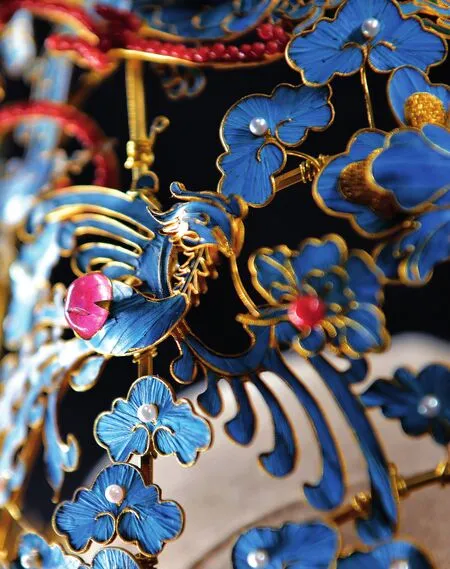手牵指绕绝技从陕西街行来
◇ 文 |本刊记者 董 茜 图 |受访者提供
手牵指绕绝技从陕西街行来
◇ 文 |本刊记者 董 茜 图 |受访者提供
千足黄金拉丝造楼、和田美玉雕琢成台、蓝宝石祖母绿镶嵌亭台楼宇,一座以1:38微缩比例制作的“金玉圆明园大水法”,在北京圆明园遗址公园一经展出就轰动全国。早在1998年,这座身价2.33亿的“金玉圆明园大水法”在北京通过了国家级珍品鉴定。然而珍品背后,工艺师李昌义的名字却鲜为人知。
遇见李昌义是在渝中区临江门一栋居民楼,一间仅有50多平米的工作室里,堆放着各种不知名的器材。李昌义安静地坐在案桌前,手拿着焊枪轻微地前后移动,镊子上那块银薄片被烤得通红发软。
The miniaturized Old Summer Palace was exhibited in Yuanmingyuan Ruins Park, it caused a sensation across the nation.With millipede gold, nephrite, sapphire and emrald used to construct the pavilions, terraces and towers, it passed state-level treasure test in Beijing early in 1998 with the value of 233 million yuan.However, its maker, Li Changyi, was unknown to the public.
When I met him, he was working in a small and crowded workroom with only 50-squaremeters large, located in Linjiangmen, Yuzhong District.Sitting quietly in front of the table, he was moving the wielding pistol back and forth.The silver slice on the tweezer was roasted red and soft.




最后一块“老骨头”
The Last Piece of “Old Bone”
花丝镶嵌是个手上过的慢工活,把金银打块、搓条之前,金银必须先压制成块。虽然现在的机械已经完全解决了压制问题,但李昌义还是坚持手工压片。成条的银块被放在拔丝眼里,随着手指的牵动,一缕缕成丝而出。0.05毫米的银丝,需要经过好几次拔搓,李昌义全程严肃脸,与窗外的车水马龙似乎是相互平行而没有交集。
传统的金银加工不外乎镀金、熔金、铸金、花丝等18种技法,趁着体息的空隙,李昌义说起自己的花丝绝技,从一件银饰的设计到成品,最具价值也最能体现最高技艺的就是花丝工艺。一件花丝镶嵌工艺的作品,包含扭、填、焊、堆、垒、编、织、穿等工序。这样纷繁的工艺,在当下黄金饰品制作中早已被摒弃,取而代之的仅是金银加工中的简单冷工艺。
“我23岁当学徒的时候,光是练高精度焊接,就要几年时间。”师出重庆金属工艺厂的李昌义,总是把“精细点”挂在嘴边,他还要求学徒要有美术功底,必须学习绘画。他认为,创造力和与生俱来的美感,是花丝匠人的基本素养。“在我们这个行业里,几年时间能出一个花丝技工。但要想出个大师,就要看素养了。”
严要求、高标准的技艺传授,加上冬练三九、夏练三伏的长时间弯腰细雕,让他不少徒弟知难而退。“徒弟要走,也很正常。毕竟我们这一行,路子窄,难出头。”李昌义很清楚,如今市面上样式新颖、设计时尚感强的金银饰品,已是大势所趋。他笑着说自己就是个不懂变通的“老骨头”,坚守传统技法,在花丝镶嵌工艺中游走。身为省级工艺美术大师,他选择淡然而执着地精细打磨手中的饰品构件。
Filigree decoration is a complex job.Gold and silver must be pressed into lumps before being rubbed into strips.Li Changyi adhered to handling these by his hands without using machines.With the master’s fi ngers controlling them, silver strips underwent wire drawing processing to become silk.To make the silver silk 0.05mm in diameter, he needed to rub the silver several times.He was so obsessed that the bustling outside world had nothing to him.
Traditional gold and silver processing involves eighteen kinds of techniques including gilding, melting, casting, fi ligree decoration and so on.While taking a break, Li Changyi talked about his fi ligree decoration stunt.He said that in the whole process of making, the most sophisticated technique was filigree decoration,which entailed a series of procedures including twisting,fi lling, welding, weaving etc.However, such a technique has given way to simple cooling technique in gold orna-ment production.
“When I was 23, I served my apprenticeship.At that time, it took several years to practice high precision welding.” Li Changyi always taught his apprentices the philosophy of “making it more delicate” and asked them to learn arts and drawing, which are compulsory for artisans.“In this fi eld, it takes several years’ efforts to make a fi ligree decoration worker, but it takes literacy to be a master.”
Li Changyi was extremely strict with his cubs,which made many a disciple beat a retreat.He never feels upset about that, because it is too hard to succeed while fashionably designed gold and silver ornaments are increasingly popular today.But he still holds fast to traditional techniques and handles filigree decoration skillfully.

陕西街上的辉煌
Glorious Times in Shaanxi Street
上世纪50年代,重庆金属工艺厂尚处鼎盛时期,厂里单是花丝镶嵌匠人就有200多位。到上世纪80年代,以首饰为主产品的订单也能排起长队,在供销两旺的年头里,厂里曾创下过年产值1个亿的记录。而后的10年光景中,从沿海引进的先进设备和时尚设计理念,将市场拉开了一条大口子。消费者对饰品新样式的需求,让李昌义和同事们不得不面临转型。另谋生路的花丝镶嵌工人,纷纷放下了工具,淡忘花丝镶嵌带来过的成就。
“抗战时期,重庆的银饰行业非常了得。那时重庆的银楼、银铺就有200多家。大青楼银楼、老凤祥银楼都是响当当的名字。”李昌义从没有忘记师傅讲过的那段历史。花丝镶嵌传统工艺发源于唐代,特别是在宫廷银饰品中使用甚广。花丝镶嵌与景泰蓝、玉雕、牙雕、京绣等八大工艺门类并成为“燕京八绝”。重庆的花丝镶嵌起步晚,直到抗战时期,才靠着从北京和江浙地区撤到大后方的诸多工匠将这一工艺带到了重庆。天南地北的匠人,在重庆银楼、银铺扎根,也使得重庆的花丝镶嵌工艺融合多家流派之所长,进而创新了艺术设计,改良了技艺,让重庆花丝镶嵌独树一帜。
“特别是在陕西街一带,匠人非常集中。”凭着老一辈的记忆,李昌义依稀能还原那时的场景。曾有“中国华尔街”之称的陕西街,不仅钱庄、银楼扎堆,就是走街串巷的摆摊银匠,都能使上几招拉丝镶嵌的绝活,打造一些款式各异的金银饰品。
In 1950s, Chongqing Metal Craft Factory was at its zenith when over 200 craftsmen worked on filigree decoration.By 1980s, the onslaught of orders, mainly jewelry, created an annual production of 100 millionYuan during the booming year.In the next decade, when advanced equipment and stylish design concept were introduced, it declined a lot.Consumers’ need for fashionable jewelry compelled Li Changyi and his colleagues to change, leave behind their achievements on filigree decoration and seek for a living.
Li Changyi always remembers the glorious history of the silver jewelry industry in Chongqing that his master told him.During the anti-Japanese war, there were more than 200 silverware stores and shops, including the famous Da Qing lou and Lao Feng xiang.Filigree decoration originated from Tang Dynasty and was widely used at court.Eight craft categories, including fi ligree decoration, cloisonne, jade carving, ivory carving, Beijing embroidery, etc.were called “the Eight Unique of Yanjing”.
Filigree decoration started late in Chongqing when numerous craftsmen withdrew from Beijing and Jiangsu-Zhejiang region to the rear areas in the wartime.They took handicraft skills to Chongqing and put down roots in silverware stores and shops, so that various schools of filigree decoration intermingled with each other accompanied with creative art design and improved techniques, making Chongqing filigree decoration one and only.
“Craftsmen were especially centered in the Shaanxi Street.” Li Changyi has a hazy memory of the scene according to the stories the older told him.Once called“China’s Wall Street”, Shaanxi Street was the hub of banks and silverware stores.Even the silver vendors mastered some exclusive skills to make all sorts of gold and silver jewelry.





甄嬛传里的老手艺
Traditional Handicraft in the Hit TV Series
如今的陕西街,早已不见老凤祥、老天宝、杨和庆、金雀钗等新旧银楼竞价抢客的景象。花丝镶嵌工艺一度失传,却也因此显得弥足珍贵。“再好的师傅,也要考虑吃饭。”李昌义知道,坚持手工制作银饰才能体现技艺的高超,但这条路如果要走下去,未来如何无人知晓。
不过,持之以恒从来都是造就大师的必经之路。
李昌义觉得自己是幸运的。因为坚守,他迎来了自己的收获,同时也迎来了世人对花丝镶嵌的认可。最近几年各大卫视热播的电视剧《甄嬛传》便是其中一例,它让李昌义这样的手艺人看到了花丝镶嵌新的生机。
剧中,演员蔡少芬头上戴的花丝烧蓝点翠首饰,孙俪头上的凤凰金钗,后宫嫔妃们手指上长长的护甲套等等,全都得靠花丝镶嵌技法制作。“据说这部戏的服装购置费用上百万,而花丝镶嵌工艺制作的首饰费用就要60多万。”李昌义很欣慰,一部热门古装剧,让更多的人欣赏到了花丝镶嵌技艺的精湛与美。更令他满足的是,打造这些宫廷传统饰品的主创,正是自己的关门弟子左书桥。对年过六旬的李昌义来说,这些成就意味着他这辈子最大的使命就要完成了。
Today, Shaanxi Street no longer witnesses the competitive bidding scene to attract customers among Lao Feng xiang, Lao Tian bao, Yang He qing and Jin Que chai.The handicraft of filigree decoration was lost in antiquity at one time; consequently, it is regarded as a treasure.“Even a skillful craftsman has to make a living.” no one knows what is the future of this technique.Nevertheless, Li believes that only hand-made silver jewelry re fl ected the splendid craft.
Yet, perseverance is always the essential way to be a master.
Li Changyi thinks he is lucky, because he has won harvest and seen the promising future of fi ligree decoration when it gains public reputation as fi ligree jewelries were shown in the hit TV series the Legend of Zhenhuan.
In the episodes, either famous actress Cai Shaofen,Sun Li or emperor’s concubines wear the ornaments of fi ligree decoration.“It is said that the costume costs up to one million, and making those fi ligree jewelries takes up over 600,000.” Li Changyi was satisfied that the blockbuster TV has introduced the handiwork to more.Also, he was proud that the chief designer of those works is his last disciple Zuo Shuqiao.Now in his sixties, Li feels self-accomplished as of the great mission throughout his life.
Master with Magic Fingers
Article | Dong Qian Pictures | Interviewee

